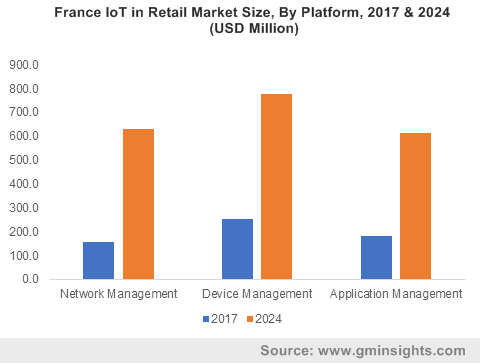

Published Date: August 2019
IoT in Retail Market size is set to exceed USD 35 billion by 2024; according to a new research report by Global Market Insights Inc.
The increasing government initiatives in Asian and European countries for the enhancement of the traditional retail sector are driving the IoT in retail market. Governments are aiding retailers to deploy advanced & digitized products to offer high efficiency & consumer attraction benefits. The government of India has taken several initiatives to improve the retail sector such as allowing 100% Foreign Direct Investment (FDI) in a single-brand retail under the automatic route without government approval and with liberalized local sourcing norms. Moreover, the transformation of brick & mortar stores, which now use digital payments, digital signages, etc., is adding up to industry development. Technical advancements in the field of IoT & retail along with the increasing awareness will boost the demand for these solutions.
Factors, such as high implementation cost and rise in service costs associated with technology, might limit the IoT in retail market growth. Considering that the technology is in its nascent stage and involves high development costs owing to the advanced features possessed by these machines, these technological devices are generally priced high and targeted at individuals or organizations with high purchasing power. The increased cost of implementation might act as a barrier to the mass adoption even with the availability of the right financing option.

Get more details on this report - Request Free Sample PDF
Several technologies used in the retail platforms include beacons, videos, etc. Beacons in IoT devices offer capabilities such as mobile application exposure, employee measurement, and customer path analytics. The major uses of beacon technology in IoT include shopper engagement & service, proximity-based messaging, and personalized communication. The implementation of these components in technically advanced solutions will increase the store capabilities and aid in serving the customers in better ways.
The emergence of cloud-based software platforms for various applications, such as data management, security, and remote monitoring, is creating a demand for software components in the IoT in retail market. Moreover, the integration of smartphones and tablets to manage retail store operations will increase the implementation of such software. Information technology companies offer efficient retail specific IoT solutions that are a combination of software and hardware components.
Browse key industry insights spread across 150 pages with 130 market data tables & 12 figures & charts from the report, “IoT in Retail Market Size, By Platform (Network Management, Device Management, Application Management), By Technology (Sensors, RFID, Connectivity Technology), By Component (Hardware, Software [Data Management, Streaming Analytics, Security, Remote Monitoring, Bandwidth Management], Service [Professional Service, Managed Service]), By Application (Digital Signage, Supply Chain Management, Payment, Smart Shelf & Doors), Industry Analysis Report, Regional Outlook, Application Potential, Price Trends, Competitive Market Share & Forecast, 2018 – 2024”in detail along with the table of contents:
https://www.gminsights.com/industry-analysis/iot-internet-of-things-retail-market
IoT-based payment solutions deployed by smart retailers offer advantages, such as enhanced cash management and smartphone integrated payments, that aid in the expansion of the IoT in retail market. With the help of intelligent payment solutions, retailers have developed mobile applications that enable customers to pay from anywhere, eliminating long waits at retail stores. In-store payment solutions, such as the POS systems, RFID readers, and printers, aid in gaining information about the customers’ previous purchases, account bonus points, and customized discounts. The increasing implementation of payment solutions eliminates customer hassles and allows convenient payments. Personalized discounts and automated checkouts are the key features that attract customer involvement & repurchase, further increasing the retailer sales.
The IoT sector in Brazil is expected to witness significant growth due to the development of automotive, manufacturing, and retail industries. The increasing investments in the Brazilian retail sector are further contributing to the implementation of IoT platforms in the region. The major retail firms include Walmart, Pao de Acucar, Carrefour S.A., Lojas Renner, etc., which are deploying IoT solutions to cater to the increased customer requirements. The Brazilian government has adopted initiatives to encourage new collaborations & partnerships, start-ups, and learning institutes to develop IoT technology. Moreover, companies are increasing their investments in Brazil to support the IoT development strategy. In September 2018, Qualcomm announced the launch of its laboratory in Brazil to achieve advancements in its IoT strategies.
Key companies present in the IoT in retail market are Cisco Systems, Microsoft Corporation, IBM Corporation, Foxconn Technology Group, Bosch Software Innovations GmbH, Dell Inc., Hitachi Ltd., etc. The companies are involved in developing highly efficient and retail-specific IoT-based solutions to aid retailers in gaining high consumer attention. These companies also offer overall store solutions including software, platforms, and services to serve customers better. For instance, in January 2018, Intel Corporation announced a partnership with the IoT startup, Rubikloud. The USD 37 million investment led by Intel is aimed at helping retailers to make use of AI to compete with other retail giants such as Walmart, Amazon, etc.
The IoT in retail market research report includes in-depth coverage of the industry with estimates & forecast in terms of revenue in USD from 2013 to 2024, for the following segments:
By Platform
By Technology
By Component
By Application
The above information is provided for the following regions and countries:
Preeti Wadhwani, Prasenjit Saha